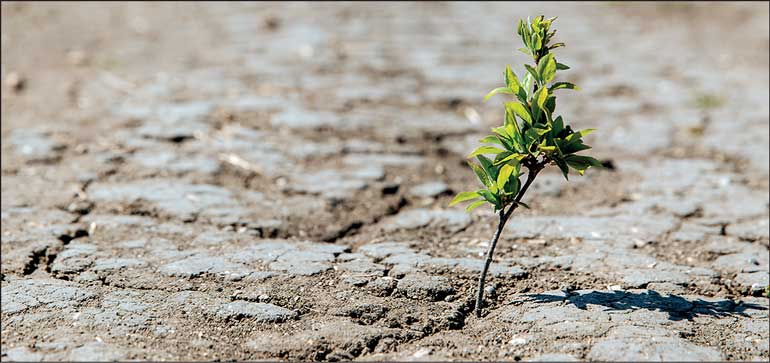Thursday Dec 11, 2025
Thursday Dec 11, 2025
Wednesday, 27 December 2023 00:20 - - {{hitsCtrl.values.hits}}

Educating the public on climate change and its impacts will create a supportive environment for mitigation policies and action
 Sri Lanka is ranked high in terms of climate change impacts facing a multitude of hazards. Impacts of climate change vary by location and severity due to the presence of different climatic zones, varying topography, and diverse land use patterns of the country. Severe wet weather events often result in floods and earth slides while dry events lead to droughts and wildfires. Although we are yet to experience the consequences of rising sea levels, according to the forecasts a considerable portion of our coastal lands will be under water by the end of this century. We witness health impacts due to gradually increasing temperatures. Human mobility due to certain climate impacts is not well researched as yet which would otherwise be an emerging social issue. As a dire environmental impact biodiversity loss too is not adequately discussed which is hard to monitor.
Sri Lanka is ranked high in terms of climate change impacts facing a multitude of hazards. Impacts of climate change vary by location and severity due to the presence of different climatic zones, varying topography, and diverse land use patterns of the country. Severe wet weather events often result in floods and earth slides while dry events lead to droughts and wildfires. Although we are yet to experience the consequences of rising sea levels, according to the forecasts a considerable portion of our coastal lands will be under water by the end of this century. We witness health impacts due to gradually increasing temperatures. Human mobility due to certain climate impacts is not well researched as yet which would otherwise be an emerging social issue. As a dire environmental impact biodiversity loss too is not adequately discussed which is hard to monitor.
Although all climate change impacts are detrimental, they bring about unequal consequences to the people and economy. Hence, it is very important to identify types of risks and hazards, assess them based on strategically developed criteria, and prioritise them before moving on to the mitigation stage where investment decisions are made. This would pave the way for making fair decisions and to allocate resources efficiently for mitigating urgent and important impacts first.
Government’s role in mitigation
In Sri Lanka, the Disaster Mitigation Centre is the pivotal organisation in charge of disaster mitigation supported by many other organisations based on their specialties. For instance, the Irrigation Department deals with flood mitigation while the National Building Research Organization deals with landslides. In addition, various projects implemented under foreign funds deal with climate risk mitigation in different sectors. As a result, climate impact assessment and ranking take place at the organisational levels largely depending on resource availability including financial provisions of each organisation. If these impacts are assessed and prioritised strategically on a national basis for mitigation most severe issues can be solved irrespective of the nature of the hazard and the area affected.
Need for a detailed assessment
Ranking of climate change impacts should be done rationally and fairly given the fact the country is unable to address all those issues at once. A set of criteria should be developed which is based on economic, social, environmental, and humanitarian aspects of the affected area and people. The risk can be estimated based on factors like immediacy, frequency, magnitude, severity, and the potential for ripple effects across other critical sectors as these impacts are often interconnected.
Special attention would be needed for marginalised and vulnerable communities so that disparities faced by them are narrowed down as much as possible. This would promote equity and justice in climate change mitigation efforts.
Excessive heat, fast-spreading communicable diseases, and extreme weather events pose immediate risks to public health and safety. Exposure to excessive heat can lead to heat exhaustion and heatstroke, which can be life-threatening. As an indirect impact, prolonged exposure can aggravate existing health issues, such as cardiovascular and respiratory diseases.
Climate change is immensely contributing to biodiversity loss damaging ecosystems as well. The cause for this calamity is the gradual shift in climatic zones as climate change alters temperature and precipitation patterns across the territories. Hence, it is very important to decide at what level these impacts are placed on a prioritisation scale.
The occurrence of erratic weather patterns and associated extreme events in Sri Lanka is on the rise when compared to the historical data. Given the fact that nearly 25% of the workforce is engaged in agriculture frequent floods and droughts will affect their livelihoods with detrimental economic consequences as well.
Prioritising impacts based on cost-effectiveness in mitigation would be another criterion that can be used. The benefit gained per unit of investment will optimise resource allocation for mitigation.
Empowering people
The Government’s priorities should be conveyed to the people and action to be taken transparently. It is very important to acknowledge the importance of public engagement which would enable the Government to make meaningful decisions. Further educating the public on climate change and its impacts will create a supportive environment for mitigation policies and action.
Remarks
Sri Lanka is already collaborating with the developed world to tackle the issue of climate change and its severe impacts. In the meantime, it is prudent for the country to study the potential impacts of climate change risk in detail as discussed before making investment decisions considering the prevailing weak economic situation. Without such prioritisation, it will be hard to convince even the political authorities who always tend to make political decisions in this regard. The mitigation measures should be proactive as opposed to reactive approaches we see after a disaster strikes. Hence, taking fair action in this regard is a moral obligation of all parties involved as the number of people affected by climate change impacts is rapidly on the rise.
(The writer is a chartered Civil Engineer specialising in water resources engineering.)